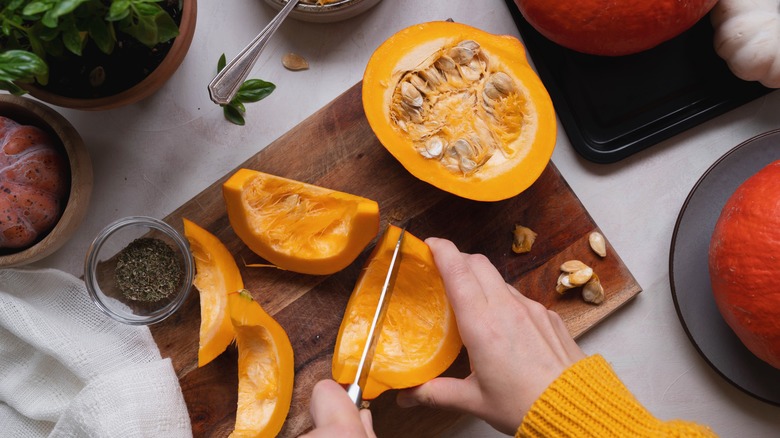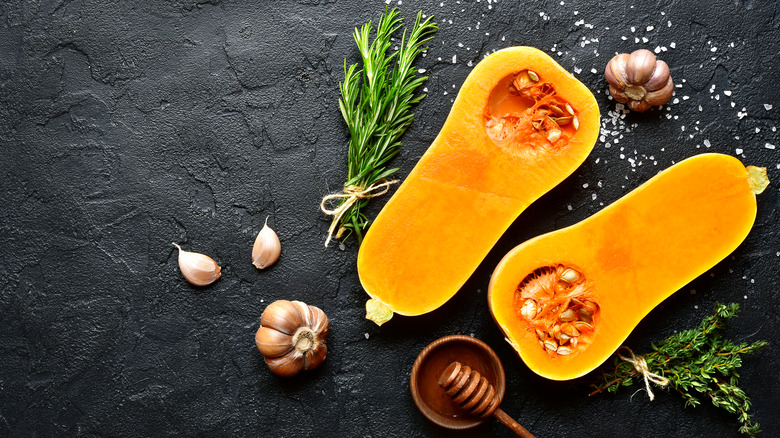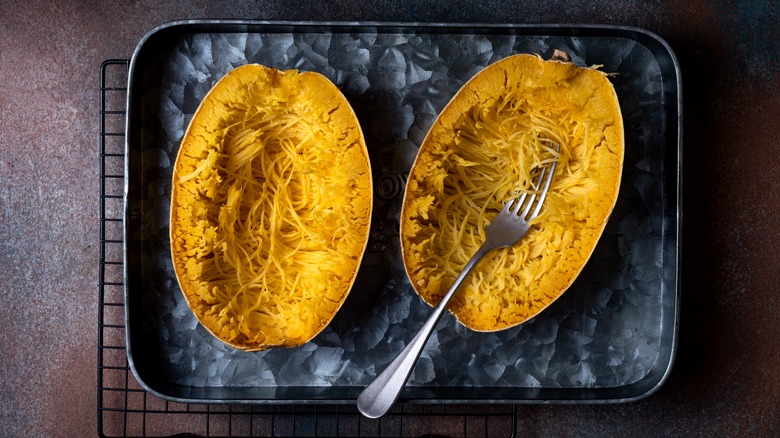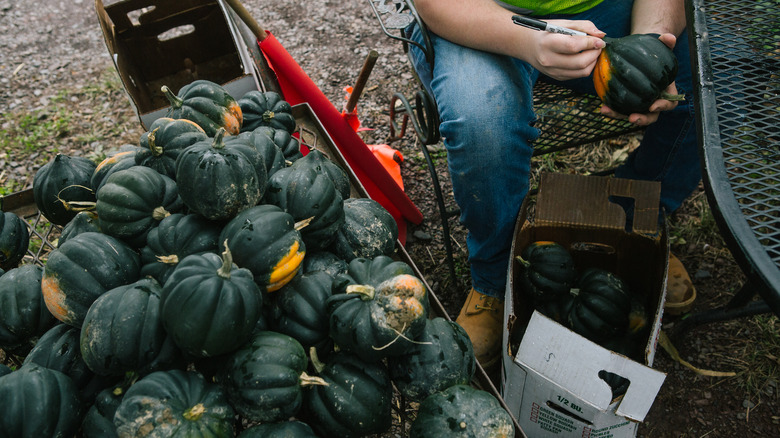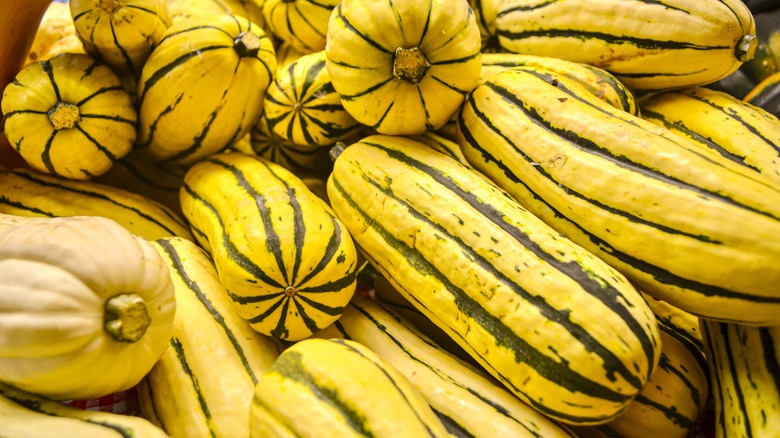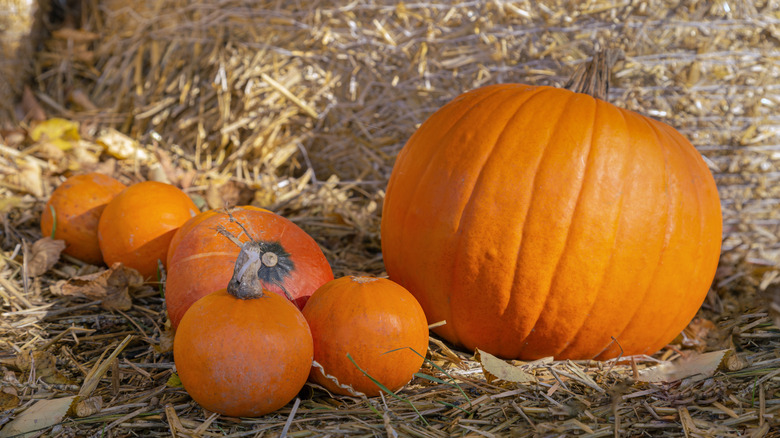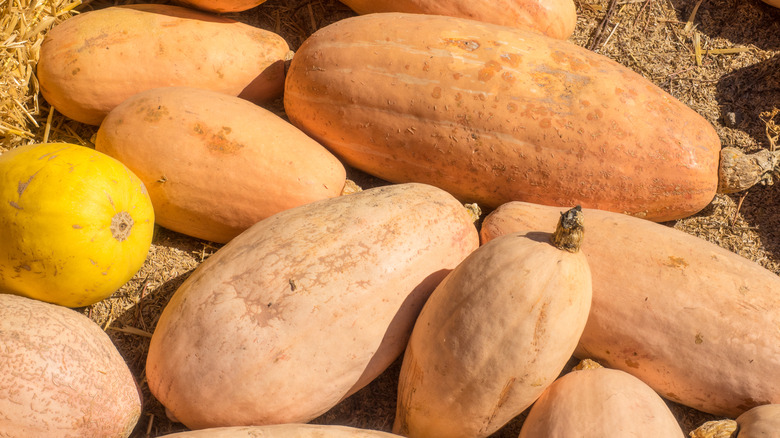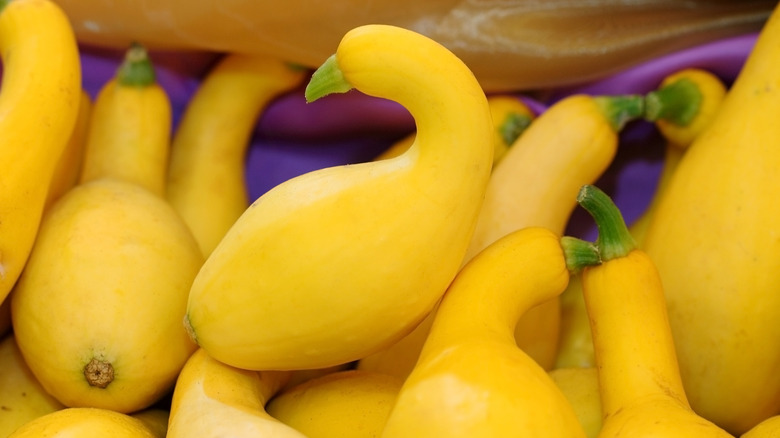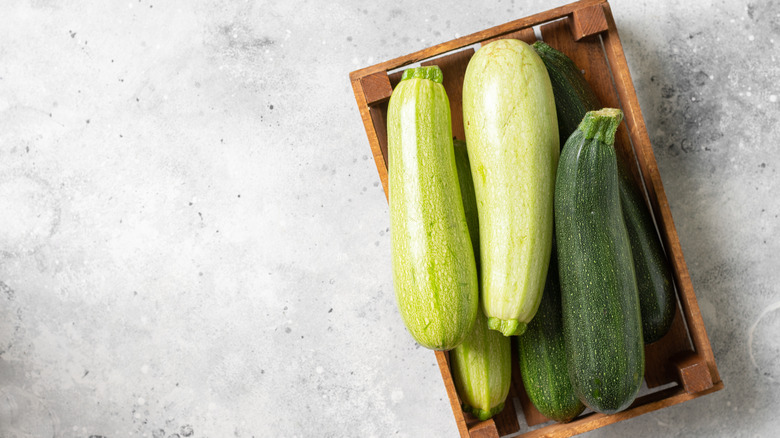The Most Popular Types Of Squash Explained
The varieties of squash are seemingly endless, but there are a few constants throughout them all — squash are straightforward, packed with vitamins, fairly easily accessible, and incredibly delicious. Squash can be broken into two main categories: winter and summer, according to Food Revolution Network. Winter squash come with a harder, thicker inedible skin, and summer squash with a softer, thin and edible one. While all squash can basically be cooked the same way, winter squash is best roasted as a side dish or pureed into a warm and comforting soup, while summer squash can be tossed on the grilled or served up raw in a sharp and palate cleansing salad medley.
We've all walked through an outdoor market and seen massive piles of squash, gourds, and pumpkins and never quite knew exactly what we were looking at. Now, you'll be able to not only identify what is stacked in front of you, but you'll be able to pick out which squash are best and fill your kitchen table with their nutrient-rich tastiness.
Butternut Squash
While butternut squash is technically a member of the winter squash family, it remains the flagship squash at any fall farmer's market all year round. According to Live, Eat, Learn, butternut squashes are harvested during the turn of summer into autumn, but their long lasting shelf life makes them readily available throughout the year. While picking out a butternut squash at your local grocery store or market, the more firm, the better. Seek out butternut squashes with a hard rind, sturdy skin and no deep gashes (light scratches or nicks are okay). Whole butternut squashes kept in a cool, dark location will remain in good shape for about a month. Once cut, however, the squash will only remain good for about one week if kept in a refrigerated, air tight container.
Squashes come in a wide variety of shapes and sizes, so breaking a butternut squash down to your necessary sizing can be tricky if you're only familiar with a different kind. First, cut off the top and bottom ends to stabilize the fruit (yes, squash are fruit), half the squash vertically, and use a spoon to remove the seeds and stringy innards. From there, the squash can be cubed or roasted, either peeled or unpeeled.
Spaghetti Squash
Another winter squash, spaghetti squash gets its name from its uncanny resemblance to spaghetti noodles after having been cooked, according to Mercola Food Facts. Of course, spaghetti squash does not taste like pasta, but its mild flavor and similar texture make it a low-carb, nutritiously bountiful substitute alongside your favorite sauce. While pasta and spaghetti squash alike contain low amounts of fat, salt, and fiber, pasta contains over five times as many calories per serving than spaghetti squash. Furthermore, spaghetti squash is a good source of protein.
Like butternut squash, select your spaghetti squash based on the firmness of the rind and an absence of bruises or soft spots. Spaghetti squashes vary in color, coming in white, pale yellow, orange, and even patterned. If available, we recommend choosing orange spaghetti squash, as their color comes from their high beta-carotene content, a pigment that converts into Vitamin A through digestion. Spaghetti squash is also rich in folate for new cell development, potassium to regulate blood pressure, calcium, iron, phosphorus, and zinc.
Spaghetti squash has a similar shape as butternut squash and can be broken down the same way. After scooping and discarding the seeds and pulp, however, the squash can be raked from the peel using a fork. Then, your squash is ready to be used in whatever recipe sits atop your kitchen counter.
Acorn Squash
Acorn squash comes in three different varieties: gold, green, and white. All three are available from the fall into the winter, according to Specialty Produce. Acorn squash is known to have been first domesticated by Native Americans, and is part of a group of crops known as "the three sisters" with corn and beans, as these three crops were planted together because of their "mutually beneficial relationship."
Gold and green acorn squash are basically interchangeable, both yielding a sweet and nutty flavor when cooked. White acorn squash, on the other hand, is also known as pepper squash, due to its more savory flavor containing notes of black pepper. White acorn squash is more rare and only available at some farmer's markets and distributors. Gold acorn squash is more accessible than white, but not as much as green, which can generally be found anywhere from your local farm to chain supermarkets.
All three varieties of acorn squash are excellent sources of vitamin C, vitamin B6, potassium, and dietary fibers. Acorn squash can be prepared and cooked like most other squash and makes a hearty, healthy, vibrantly colored side dish to whatever main course sits beside it.
Delicata Squash
Not only delicious and abundant in vitamins, Delicata squash is also very attractive looking with a vibrant yellow color and green pinstripes, making it both edible and ornamental. According to Farmer's Almanac, this winter squash has a very sweet flavor and is also incredibly versatile. It can be roasted whole or cubed, stuffed and baked, boiled or sauteed. Another great aspect of convenience of delicata is its edible peel — there is no need to remove its peel before eating, so other than the usual halving and seed removal, delicata is quickly ready to be enjoyed. (Plus, delicata seeds can be roasted just the same as pumpkin seeds.) While delicata has less beta-carotene than other winter squashes, it still contains high levels of vitamins C and B, potassium, and dietary fibers.
The reason for delicata's popularity only just beginning is because the squash used to be "highly prone to mildew diseases." While delicata seeds have been available in the U.S. since the late 19th century, this squash all but disappeared following the Great Depression. It was not until the early 2000s when "an open-pollinated, non-hybrid variety resistant to typical squash diseases" was bred by Cornell University's Department of Plant Breeding that the squash began to grow in popularity. The result has provided food growers and distributors a healthy, plentiful annual harvest.
Sugar Pumpkin
Every fall, pumpkins begin to appear everywhere — from the pick-your-own fields to the market to your front stoop. But this squash has many uses other than carving Jack-o'-Lanterns, provided you choose the correct type. Sugar pumpkins (also known as pie pumpkins) are beloved for their sweet and deep pumpkin flavor, according to Cook's Info. Smaller than other pumpkins you may be familiar with, sugar pumpkins also have a thicker flesh, are less moist, and have a less stringy interior, making it the superior choice for baking and cooking. This more solid flesh turns a deliciously creamy and buttery texture after cooking or baking. Despite the name of this squash, however, sugar pumpkins can be widely utilized in savory applications in addition to the pumpkin pie you're probably imagining.
Sugar pumpkins look essentially the same as the carving pumpkins you pick at the pumpkin patch, except for the size. These squash are usually between eight and 10 inches wide and weigh between six and 10 pounds. This small size is perfect for roasting, as a regular size sheet pan can fit multiple full sugar pumpkins at once. Roasting your sugar pumpkin is as easy as halving and removing the inner seeds and guts with a spoon, brushing with olive oil, and placing them in the oven. According to Oh She Glows, the best way to do so is by removing the stem before slicing the squash in half. Roasting can be done with the skin on and will be easily peelable a few minutes after coming out of the oven.
Banana Squash
At first glance, banana squash may not look very appealing because of its blob shape and pale color, but the aroma and taste of cooked banana squash can stand up to any of its fellow winter brethren. Available throughout fall and winter, banana squash is often found at the market alongside butternut, spaghetti, or acorn squash. Banana squash is just as nutritious and simple to prepare, so it's bland appearance is no reason for it to be overlooked. According to Organic Facts, the size of whole banana squashes can be a little daunting, as the squash can grow to weigh anywhere between ten and 35 pounds. For this reason, some grocers sell banana squash pre-sliced. Banana squash contains all the vitamin C, vitamin B6, potassium, and dietary fibers of other winter squashes, in addition to its high beta-carotene content like spaghetti squash.
Banana squash can be halved and cubed like other squashes, but it's very thick skin and sometimes large size may require the added step of wrapping the squash in a towel and breaking into smaller pieces. While you won't want to eat the think skin, its inner seeds can be rinsed, roasted, and snacked on the same as others. Banana squash is great sliced into strips, seasoned, and grilled, as well as roasted in the oven. It makes a perfect side dish on its own or in a squash medley, pureed into a soup, or cubed in a salad.
Crookneck Squash
Crookneck is a summer squash sure to bring vibrance, nutrition, and flavor to your next barbecue. Crookneck squash are pretty identifiable based on the name alone, but their sharp, bright yellow color will definitely catch your eye. Organic Facts shares that, as time goes on, crookneck squash will turn from a bright yellow to a more orange color and become tougher and less sweet. This squash is the most sweet earlier in the season, when they are still soft and smaller in size, about four to five inches long. Like winter squashes, summer squashes like crookneck squash are high in vitamins and low in calories. In fact, 100 grams of crookneck squash contains only 19 calories, making it the perfect vegetable to balance a summer of hamburgers and hot dogs.
Summer squash can be prepared just the same as winter squash (or most any other vegetable): cubed and roasted, sliced and grilled, sautéed, or skewered and cooked as a kebab. Overcooking this squash, however, will yield a particularly soggy and wilted product. Summer squashes like the crookneck have an entirely edible skin, so they can be stuffed with the filling of your choice after removing the innards with a spoon.
Zucchini
Zucchini squash is arguably the most popular summer squash. Though officially in season between May and August, according to Spices Inc, zucchini is generally available year round at grocery stores. The color of zucchini squash varies in different shades of green, very similar to cucumbers, but zucchini with the most flavor will be smaller, with a firm, glossy skin. While zucchini can grow to over a foot long and may be more convenient for entertaining, these will not be as flavorful. This squash is rich in vitamins and high in water content, so its freshness and lightness makes it taste as good as it is for us.
Zucchini can be sliced and grilled, cubed and sauteed or kebabbed, and can even be breaded and fried. Chopped zucchini makes for a light and refreshing addition to salads, while fried zucchini can make a delicious alternative to french fries. This squash is so rich in flavor the only seasoning it really needs is a light brushing of butter or olive oil, and some salt and pepper. Zucchini (like other summer squashes) does not have as long a shelf life as winter squashes, and will last up to a week in your refrigerator.
